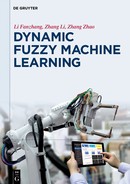Contents
1Dynamic fuzzy machine learning model
1.2.3DFML geometric model description
1.3Relative algorithm of DFMLS
1.3.1Parameter learning algorithm for DFMLS
1.3.2Maximum likelihood estimation algorithm in DFMLS
1.4Process control model of DFMLS
1.4.1Process control model of DFMLS
1.4.3Design of dynamic fuzzy learning controller
1.5Dynamic fuzzy relational learning algorithm
1.5.1An outline of relational learning
2Dynamic fuzzy autonomic learning subspace algorithm
2.1Research status of autonomic learning
2.2Theoretical system of autonomous learning subspace based on DFL
2.2.2Axiom system of AL subspace
2.3Algorithm of ALSS based on DFL
2.3.2Algorithm of ALSS based on DFL
3Dynamic fuzzy decision tree learning
3.1Research status of decision trees
3.2Decision tree methods for a dynamic fuzzy lattice
3.2.1ID3 algorithm and examples
3.2.2Characteristics of dynamic fuzzy analysis of decision trees
3.2.3Representation methods for dynamic fuzzy problems in decision trees
3.2.4DFDT classification attribute selection algorithm
3.2.5Dynamic fuzzy binary decision tree
3.3DFDT special attribute processing technique
3.3.1Classification of attributes
3.3.2Process used for enumerated attributes by DFDT
3.3.3Process used for numeric attributes by DFDT
3.3.4Methods to process missing value attributes in DFDT
3.5.1Comparison of algorithm execution
3.5.2Comparison of training accuracy
3.5.3Comprehensibility comparisons
4Concept learning based on dynamic fuzzy sets
4.1Relationship between dynamic fuzzy sets and concept learning
4.2Representation model of dynamic fuzzy concepts
4.3DF concept learning space model
4.3.1Order model of DF concept learning
4.3.2DF concept learning calculation model
4.3.3Dimensionality reduction model of DF instances
4.3.4Dimensionality reduction model of DF attribute space
4.4Concept learning model based on DF lattice
4.4.1Construction of classical concept lattice
4.4.2Constructing lattice algorithm based on DFS
4.4.3DF Concept Lattice Reduction
4.4.4Extraction of DF concept rules
4.4.5Examples of algorithms and experimental analysis
4.5Concept learning model based on DFDT
4.5.1DF concept tree and generating strategy
4.5.2Generation of DF Concepts
4.5.3DF concept rule extraction and matching algorithm
4.6Application examples and analysis
4.6.1Face recognition experiment based on DF concept lattice
4.6.2Data classification experiments on UCI datasets
5Semi-supervised multi-task learning based on dynamic fuzzy sets
5.1.1Review of semi-supervised multi-task learning
5.2Semi-supervised multi-task learning model
5.3Semi-supervised multi-task learning model based on DFS
5.3.1Dynamic fuzzy machine learning model
5.3.2Dynamic fuzzy semi-supervised learning model
5.4Dynamic fuzzy semi-supervised multi-task matching algorithm
5.4.1Dynamic fuzzy random probability
5.4.2Dynamic fuzzy semi-supervised multi-task matching algorithm
5.5.1Mahalanobis distance metric
5.5.2Dynamic fuzzy K-nearest neighbour algorithm
5.5.3Dynamic fuzzy semi-supervised adaptive learning algorithm
6Dynamic fuzzy hierarchical relationships
6.1.1Research progress of relationship learning
6.2Inductive logic programming
6.3.1DFL relation learning algorithm (DFLR)
6.3.3Dynamic fuzzy matrix HRL algorithm
6.4Dynamic fuzzy tree hierarchical relation learning
6.4.2Dynamic fuzzy tree hierarchy relationship learning algorithm
6.5Dynamic fuzzy graph hierarchical relationship learning
6.5.1Basic concept of dynamic fuzzy graph
6.5.2Dynamic fuzzy graph hierarchical relationship learning algorithm
6.6Sample application and analysis
7Multi-agent learning model based on dynamic fuzzy logic
7.1.1Strategic classification of the agent learning method
7.1.2Characteristics of agent learning
7.2Agent mental model based on DFL
7.3Single-agent learning algorithm based on DFL
7.3.2Immediate return single-agent learning algorithm based on DFL
7.3.3Q-learning function based on DFL
7.3.4Q-learning algorithm based on DFL
7.4Multi-agent learning algorithm based on DFL
7.4.1Multi-agent learning model based on DFL
7.4.2Cooperative multi-agent learning algorithm based on DFL
7.4.3Competitive multi-agent learning algorithm based on DFL
8.1.1Definition of dynamic fuzzy sets
8.1.2Operation of dynamic fuzzy sets
8.1.3Cut set of dynamic fuzzy sets
8.1.4Dynamic fuzzy sets decomposition theorem
8.2.1The conception dynamic fuzzy relations
8.2.2Property of dynamic fuzzy relations
8.3.1Dynamic fuzzy Boolean variable
8.3.2DF proposition logic formation
